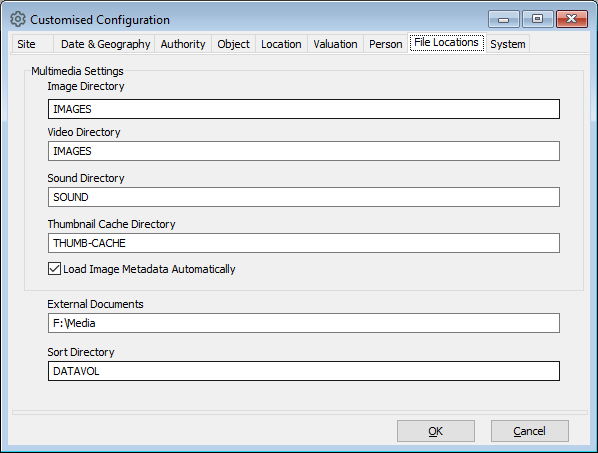Image and multimedia file storage
Learn how to store, organise, and name your images for use in Vernon CMS.
Overview
-
You add an image to Vernon CMS using its file path.
-
Vernon CMS doesn't store the image. It stores the link to where an image is kept.
-
If the image or its folder is renamed or moved, the link will break. There are tools for fixing broken image links.
Multimedia directories
The system allows you to define separate multimedia directories for image, video, sound and thumbnail files (each time a Photo/Audio-Visual record is created, a thumbnail is automatically generated).
These directories are the top-level folders used to store the different types of files. For example, the default image directory is the IMAGES folder in Wincoll. This folder may contain numerous subfolders, grouping images by department or year.

If you would like to store your image files in a different location, you will need to update the image directory. Storing your files under these directory folders means you can easily move all files to a different disk drive or folder by just updating your multimedia settings.
See Change your external file directories.
Image storage
You should save your images within one directory on your server or somewhere else permanently accessible to all users and Vernon CMS. The directory can be divided into sub-folders.
We recommend organising folders in a consistent way that won’t change, for example:
-
By accession year.
-
By artist name.
-
By number range, such as T100 to T500.
Try to have no more than about 500 images in one folder.
Image size
-
Images should be no more than 2,000-3,000 pixels on the longest side to avoid slow performance.
-
Images larger than this can be linked through the Document References window.
Image filenames
We recommend that you use the accession number or System ID as the file name for each image.
If there are multiple images for a record, use a suffix. For example:
-
2002.1-1
-
2002.1-2
-
2001_a
Filenames in Windows can't have these characters: / \ : ? < > |. If your accession numbers contain one of these characters, choose a substitute character for your filenames.
Image thumbnails
Vernon CMS automatically creates a small representative thumbnail image for each Photo/Audio-Visual record that you create. The thumbnails are stored in the Wincoll > THUMB-CACHE folder. This directory is created and maintained by the system.
You can provide your own thumbnail to override the system-created default. This is useful for video files.
-
Create an image roughly 114 x 114 pixels in size (or 114 pixels on the longest side).
-
Name the image file with the exact same name as the original file, but with .thm on the end. For example:
-
Original thumbnail file: 1994.1-oral history.avi
-
Custom thumbnail file: 1994.1-oral history.avi.thm
-
-
Save your thumbnail file in the same directory as the original image file.
The next time you open a record with this image linked, your custom thumbnail will display automatically. You do not have to delete the original thumbnail in the THUMB-CACHE folder.
Using http:// and https:// file locations
Vernon CMS can use http:// or https:// file locations. You can link images and other multimedia files stored in cloud based or intranet storage to Vernon CMS.
-
Enter the file location into the Digital Filename field in the Photo/Audio-Visual record.
-
File locations must end in a file extension (for example, .jpg, .png, .bmp).
-
Thumbnail images (such as those shown in the Object - Identification window) will not update when changes are made to a linked image. To generate a new image, right-click on the thumbnail and select Refresh.
-
Metadata is not collected from web files and will not be displayed in the Photo/Audio-Visual record.
-
You cannot use the Browse button in the Digital Filename field to browse web locations. This button will only allow you to browse your local directory.
-
You can use XML Import to bulk-create Photo/Audio-Visual records with http:// and https:// file locations.
-
You cannot use the Import and Link Images tool with http:// and https:// images.
-
Original http:// images will not display in Word Merge reports. If you wish to include http:// images in a Word Merge report, you will need to use image derivatives or thumbnails.
-
Using http:// and https:// file locations may slow your system's performance down (unless the images are stored on an intranet).
-
Some Vernon CMS features do not currently support http:// and https:// file locations.
